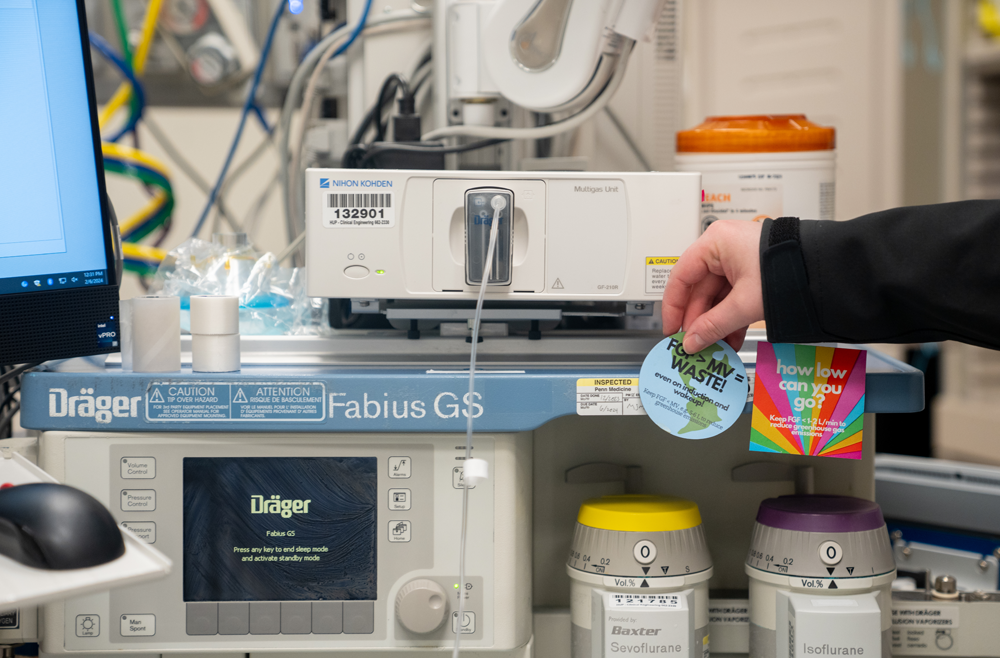
PHILADELPHIA -- In a public commitment to lead among health care organizations in reducing the industry's outsized impact on climate change, Penn Medicine has signed an ambitious national pledge promising to significantly cut and, eventually, eliminate its carbon emissions.
The Health Sector Climate Pledge is a voluntary commitment by health care organizations to slash greenhouse gas emissions by 50 percent by 2030 and achieve net zero emissions by 2050. Since it was created by the White House and the U.S. Department of Health and Human Services in 2022, the pledge has been signed by more than 130 organizations representing nearly 1,000 hospitals, health centers, suppliers, insurers, and others. It constitutes a united effort against climate change by the health care sector, which is responsible for an estimated 8.5 percent of all greenhouse gas emissions in the United States.
Signing the pledge is the latest part of Penn Medicine's commitment to a wide-reaching goal articulated in the organization's strategic plan: to become the most environmentally friendly health care organization in the nation. The health system is also part of the University of Pennsylvania's Climate and Sustainability Action Plan, which includes reaching 100 percent carbon neutrality by 2042-eight years ahead of the Health Sector Climate Pledge.
"Advancing sustainability is an investment in the future," said Kevin B. Mahoney, CEO of the University of Pennsylvania Health System. "As an industry, health care has played a role in the changing climate. We're taking a step back now to consider how to best deliver care while also balancing the ecological impact for the long-term health of our patients, the communities we serve and the generations that will follow."

Penn Medicine's plan to fulfill the objectives of the national pledge involved a year-long assessment of the carbon emissions of the health system's six hospitals and more than 150 properties. The "carbon baseline" report found that UPHS produces more than 300,000 metric tons of carbon dioxide equivalent.
Efforts to halve that number by 2030-one of the goals of the pledge-are already underway. A huge step came in December 2023, when Great Cove Solar Energy Facilities, a massive solar array in Central Pennsylvania began producing 220 megawatts of electricity each year. The energy, purchased by the university and the health system, will supply about 70 percent of the total electricity demand of the downtown Philadelphia University- and UPHS-owned properties. This renewable power purchase agreement is estimated to cut 50,000 metric tons from the health system's carbon footprint annually.
Penn Medicine is also taking steps to reduce the carbon emissions generated by employees commuting to and from work. The health system is offering employees discounted public transportation passes-costing $10, compared to the standard $96 for a monthly pass from SEPTA. Switching from driving to riding public transit can cut each employee's annual carbon emissions by more than two tons. Electric vehicle charging stations are being added at the Princeton Medical Center campus, to complement those already available on the Hospital of the University of Pennsylvania (HUP) campus.
The health system has also committed to ensuring all new building projects are designed to incorporate recycled materials, integrate expansive greenery, use less water, use less energy and qualify for Leadership in Energy and Environmental Design (LEED) Silver, or better, certification through the U.S. Green Building Council. In 2021, Penn Medicine's newest hospital, the 1.5 million-square-foot Pavilion on the HUP campus, marked a health care first when it received the prestigious LEED Gold Building Certification for Sustainability.
Across Penn Medicine, individuals, divisions, and departments have also served as catalysts for enterprise-wide efforts to go green. Examples include:

- By the end of 2024, Penn Medicine is working to phase out the use of desflurane, an anesthetic gas that remains in the atmosphere for 14 years. HUP, Penn Presbyterian Medical Center, and Penn Medicine Princeton Medical Center have already stopped using desflurane.
- Processing red bag waste-medical waste that is stained or saturated with blood-is expensive and energy intensive. Reducing the size of the "red bag" bins in the Perelman Center for Advanced Medicine's outpatient SurgiCentre effectively halved the amount of items which are actually classified as regular trash, while ensuring the medical waste is properly disposed in the red bags. The project is now being implemented at the Pavilion.
- Entities across the system collect and arrange for reprocessing of certain single-use devices such as pulse oximeters. In 2023, the health system collected more than 250,000 single-use devices, which diverted more than 10 tons of waste from landfills.
- Removing more than a dozen unused surgical instruments from the standard set used in the Division of Breast Surgery at the HUP led to lower chemical solvent use during cleaning. An expansion of the effort is in the works.
- A clinical nurse educator at Penn Presbyterian Medical Center collects opened, expired, or unused surgical supplies, including sterile drapes, sponges, sutures, and suction equipment, that can't be used for patients. Instead, the supplies are used in a training course for new operating room nurses.
- The Division of General Internal Medicine has turned off all automatic printing of lab and radiology orders as part of its growing no-print initiative. The surgery team at Penn Presbyterian digitized its three-page pathology specimen requisition form to cut down on paper waste.
- Efforts to reduce printing got a boost from new contactless check-in processes that Penn Medicine began to roll out systemwide last summer. It's designed to make care easier for both staff and patients and to reduce paper use through fully digital check-in and consent processes.






